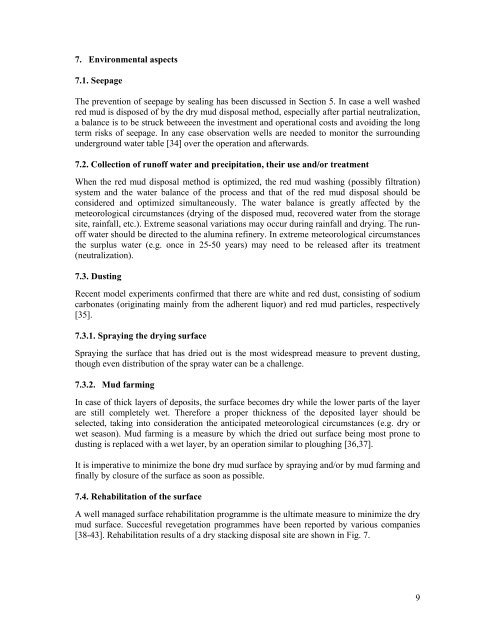De-watering, disposal and utilization of red mud: state ... - Redmud.org
De-watering, disposal and utilization of red mud: state ... - Redmud.org
De-watering, disposal and utilization of red mud: state ... - Redmud.org
Create successful ePaper yourself
Turn your PDF publications into a flip-book with our unique Google optimized e-Paper software.
7. Environmental aspects<br />
7.1. Seepage<br />
The prevention <strong>of</strong> seepage by sealing has been discussed in Section 5. In case a well washed<br />
<strong>red</strong> <strong>mud</strong> is disposed <strong>of</strong> by the dry <strong>mud</strong> <strong>disposal</strong> method, especially after partial neutralization,<br />
a balance is to be struck betweeen the investment <strong>and</strong> operational costs <strong>and</strong> avoiding the long<br />
term risks <strong>of</strong> seepage. In any case observation wells are needed to monitor the surrounding<br />
underground water table [34] over the operation <strong>and</strong> afterwards.<br />
7.2. Collection <strong>of</strong> run<strong>of</strong>f water <strong>and</strong> precipitation, their use <strong>and</strong>/or treatment<br />
When the <strong>red</strong> <strong>mud</strong> <strong>disposal</strong> method is optimized, the <strong>red</strong> <strong>mud</strong> washing (possibly filtration)<br />
system <strong>and</strong> the water balance <strong>of</strong> the process <strong>and</strong> that <strong>of</strong> the <strong>red</strong> <strong>mud</strong> <strong>disposal</strong> should be<br />
conside<strong>red</strong> <strong>and</strong> optimized simultaneously. The water balance is greatly affected by the<br />
meteorological circumstances (drying <strong>of</strong> the disposed <strong>mud</strong>, recove<strong>red</strong> water from the storage<br />
site, rainfall, etc.). Extreme seasonal variations may occur during rainfall <strong>and</strong> drying. The run<strong>of</strong>f<br />
water should be directed to the alumina refinery. In extreme meteorological circumstances<br />
the surplus water (e.g. once in 25-50 years) may need to be released after its treatment<br />
(neutralization).<br />
7.3. Dusting<br />
Recent model experiments confirmed that there are white <strong>and</strong> <strong>red</strong> dust, consisting <strong>of</strong> sodium<br />
carbonates (originating mainly from the adherent liquor) <strong>and</strong> <strong>red</strong> <strong>mud</strong> particles, respectively<br />
[35].<br />
7.3.1. Spraying the drying surface<br />
Spraying the surface that has dried out is the most widespread measure to prevent dusting,<br />
though even distribution <strong>of</strong> the spray water can be a challenge.<br />
7.3.2. Mud farming<br />
In case <strong>of</strong> thick layers <strong>of</strong> deposits, the surface becomes dry while the lower parts <strong>of</strong> the layer<br />
are still completely wet. Therefore a proper thickness <strong>of</strong> the deposited layer should be<br />
selected, taking into consideration the anticipated meteorological circumstances (e.g. dry or<br />
wet season). Mud farming is a measure by which the dried out surface being most prone to<br />
dusting is replaced with a wet layer, by an operation similar to ploughing [36,37].<br />
It is imperative to minimize the bone dry <strong>mud</strong> surface by spraying <strong>and</strong>/or by <strong>mud</strong> farming <strong>and</strong><br />
finally by closure <strong>of</strong> the surface as soon as possible.<br />
7.4. Rehabilitation <strong>of</strong> the surface<br />
A well managed surface rehabilitation programme is the ultimate measure to minimize the dry<br />
<strong>mud</strong> surface. Succesful revegetation programmes have been reported by various companies<br />
[38-43]. Rehabilitation results <strong>of</strong> a dry stacking <strong>disposal</strong> site are shown in Fig. 7.<br />
9


